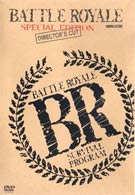"At the dawn of the Millenium, the nation collapsed. At 15% unemployment, 10 million were out of work, 800,000 students boycotted school. The adults lost confidence, and fearing the youth, eventually passed the 'Millenium Educational Reform Act'...AKA: The BR Act." - Opening Titles to Battle Royale
"This year Zentsuji Middle School number 4's Class E was chosen from among 43.000 Ninth grade classes. This year's game, said to be more blistering than the last... Oh look, there! There she is! The winner's a girl! Surviving a fierce battle that raged 2 days, 7 hours and 43 minutes... the winner is a girl! Look, she's smiling! Smiling! The girl definitely just smiled!" said a TV news reporter as the winner of the last Battle Royale returned home. Satire is an art that is lost on American movie-goers. Satire is much more than a sarcastic over-exaggeration; it is a critical vehicle for savvy political/social commentary that can be as entertaining as it is biting. On American shores, Kinji Fukasaku’s satirical Battle Royale (2000) is more of a myth or rumor than a film. The film is the story of a ninth grade class that is selected for the BR (battle royale) law. Due to the high unemployment rate and low minimum wage in Japan in the not so distant future, the youth has started a rebellious uprising. To curb revolution, the government has imposed the BR law, which selects a middle school/high school class and sends them to a remote island where the students are forced to kill each other in a last-person-standing blood bath before time runs out and the collars around their necks explode.
Sound extreme? Well it is, but the exploits are more thematic than theatric, as some of the students try to deal with the situation and the moral implications, while others throw caution into the wind and become savage murderers (a la Lord of the Flies). Much of the thematic strength of Battle Royale is its ability to parody itself. As evident in the “educational” training video explaining the law, director Fukasaku is well aware of the ridiculousness of the current “Japan-animation” trend. In fact, many scenes subtly mirror the animation mentality of whining Japanese characters with sweaty brows in both visuals and action. On the other end of the spectrum, the violence imposed by the Teacher Kitano and his army seems to echo the savagery of the Japanese during the second World War, as the children quickly abandon moral restraint in favor of victory.
Each student is given a weapon, which range from a gun or knife to a crossbow or frying pan which means the violence is savage. Chances are that the film wouldn’t pass for an R rating. It’s not that the violence is overly graphic, it is more a case of the volume of violence and the age of the kids killing each other. Perhaps even more disturbing is the moral question the main characters wrestle with. These are classmates who are forced to kill their best friends, worst enemies and love interests. As teacher Kitano voice bellows over a loud speaker playing classical music to report the day’s fresh kills, the kids sit and listen to the names of their friends who have been brutally murdered. Yet, the violence is a necessary evil, as it is the driving force behind the themes of government control of youth. Despite being six years old and from a foreign country, these themes are easy to relate with as our own country currently battles the effects of minimum wage and observes the 26th anniversary of the Kent State National Guard Shootings a mere two months ago.
While Battle Royale slaps your face in the beginning to get your attention, its pace slows and focus blurs. Toward the end, the film begins to fall into its own trap of letting the events play out, rather than developing the themes it presented in the first hour. One by one, or sometimes two by two, the students are eliminated and the film comes to a fairly predictable conclusion. Then the film continues into a series of “requiems” that seem more baffling than cathartic. They seem to attempt to provide depth between the adult teacher and the students, but hardly answer the social questions the film asks early in the film - right about the time the first collar blows the throat right out of a misbehaving student. You may be hard pressed to track down a DVD copy of Battle Royale, as there currently is no Region 1 release. However, there are two different region-free DVDs available outside the U.S. that will work on American DVD players. The out-of-print Tartan (UK) NTSC, supplement-free release can be found on eBay for a pretty penny. The other release, the two-disc Starmax (Korea) special edition, features a longer “director’s cut” of the film along with a decent video transfer and Dolby Digital and DTS 5.1 sound, plus a second disc full of bonus features (that unfortunately don’t have English subtitles). However, the Starmax subtitle translation is horrible at times, rendering the dialogue senseless.
Perhaps the easiest method of seeing this film is that the two-disc Starmax release is available on Netflix.com. Either way you find it, this DVD is worth tracking down. Not only is it an entertaining, satirical romp, but rumor has it that an American studio is remaking this Japanese gem, and odds are the American version will play up the violence as oppose to the satire that makes this film work. Here’s to hoping that an American remake will bring a special edition, region 1 release.
More information about the differences between the current releases and where to find them can be found at
Your Daily Blend of Entertainment News
[[ url ]] http://www.battleroyalefilm.net/video/index.html

